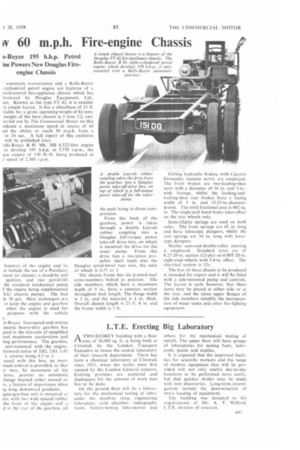vv 60 m.p.h. Fire-engine Chassis
Page 75

If you've noticed an error in this article please click here to report it so we can fix it.
s-Royce 195 b.h.p. Petrol ine Powers New Douglas Fireengine Chassis
' automatic transmission and a Rolls-Royce ,-cylindered petrol engine are features of a varcf-control fire-appliance chassis which has traduced by Douglas Equipment, Ltd., am. Known as the type FT 42, it is notable ts simple layout. It has a wheelbase of 13 ft. Rabic for a gross operating weight of 81 tons; weight of the bare chassis is 2 tans 121 cwt. arried out by The Commercial Motor on this ndicate a maximum speed in excess of 60 nd the ability to reach 50 m.p.h. from a in 34 sec. A full report of this exclusive will be published later.
ohs-Royce 113 81 Mk. 505 6,522-litre engine to develop 195 b.h.p. at 3,750 r.p.m., the que output of 330 lb.-ft. being produced at e speed of 2.300 r.p.m.
feature; of the engine and its m include the use of a Purolator ment air cleaner; a stand-by coil ignition, and two petrol-lift the standard mechanical pump f the engine being supplemented S.U. electric pumps. The fuel As 30 gal. Heat exchangers are to keep the ermine and gearbox when the engine is used for purposes with the vehicle V.
.Is-Royce four-speed-and-reverse omatie heavy-duty gearbox has pied in the interests of simplified and maximum acceleration and sing performance. The gearbox, unit-mounted with the engine, forward ratios of 3.82, 2.63, l.45 1, reverse being 4.3 to I.
usual with this box, an overinual control is provided, so that er may, by movement of the lever, prevent an automatic :hange beyond either second or rs, a feature of importance when ig long downward gradients. 'gine-gearbox unit is mounted at Ms, with two wide-spaced rubber the front of the engine and a d at the rear of the gearbox, all the pads being in direct compression.
From the back of the gearbox, power is taken through a double Layrub rubber coupling into a Douglas full-torque power take-off drive box, on which is mounted the drive for the water pump. From this drive box a two-piece propeller shaft leads into the Douglas spiral-bevel rear axle, the ratio of which is 6,57 to I.
The chassis frame has six pressed-steel cross-members bolted in position. The side members, which have a maximum depth of 9 in., have a constant section throughout their length. The flange width is 3 in, and the material is 3 in. thick. Overall chassis length is 23 ft. 8 in. and the frame width is 3 ft.
Girling hydraulic brakes, with Clayton Dewandre vacuum servo, are employed. The front brakes are two-leading-shoe units with a diameter of 16 in. and 3-in.wide facings. whilst the leading-andtrailing-shoe rear brakes have a facing width of 5 in. and 15.25-in.-diameter drums. The total frictional area is 482 sq. in. The single-pull hand brake takes effect on the rear wheels only.
Semi-elliptic springs are used on both axles. The front springs are 42 in, long and have telescopic dampers, whilst the rear springs are 54 in. long with levertype dampers.
M a rl es cam-and-double-roller steering is employed. Standard tyres are of 8.25-20-in. section (12-ply) on 6.00T-20-in. eight-stud wheels with 5.4-in. offset. The electrical system is 12v.
The first of these chassis to be produced is intended for export and it will be fitted with a side-mounted pump and controls. The layout is such, however, that these items may be placed at either side or at the rear, and the clean upper flanges of the side members simplify the incorporation of water tanks and other fire-fighting equipment.




















































































































